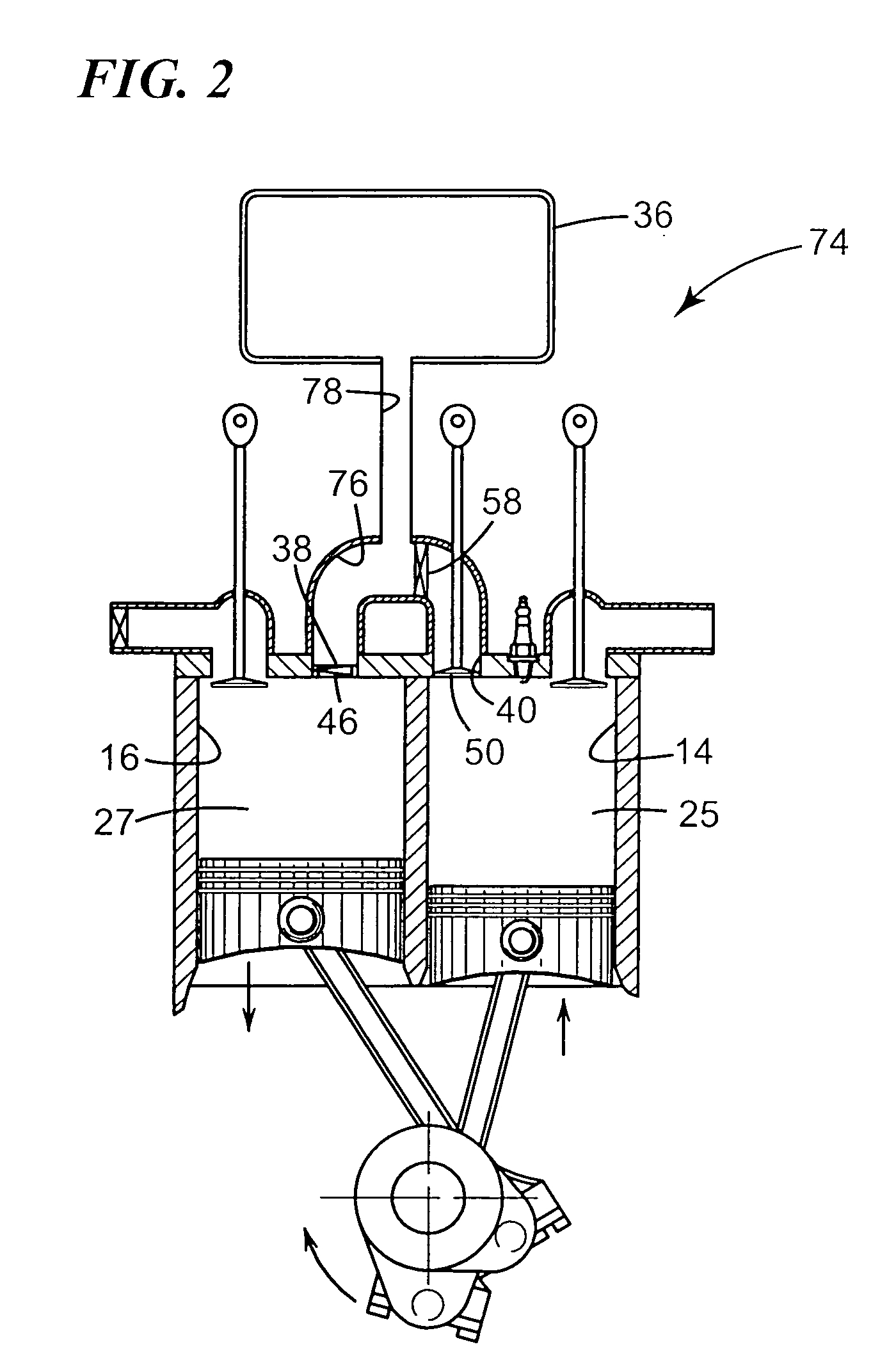Split-cycle air hybrid engine
a hybrid engine and split-cycle technology, applied in the direction of combustion engines, hot gas positive displacement engine plants, machines/engines, etc., can solve the problems of inability to optimize easily, complex valve/drive train systems, and sacrifice to compressor mode efficiency
- Summary
- Abstract
- Description
- Claims
- Application Information
AI Technical Summary
Benefits of technology
Problems solved by technology
Method used
Image
Examples
first embodiment
[0058] The cylinder head 22 includes any of various passages, ports and valves suitable for accomplishing the desired purposes of the split-cycle air hybrid engine 10. In the illustrated first embodiment, the gas passage / pressure chamber of the previously mentioned patents is replaced by a much larger air reservoir 36 connected to the head 22 through a reservoir inlet port 38 opening into the closed end of the second cylinder 16 and a reservoir outlet port 40 opening into the closed end of the first cylinder 14. As opposed to a smaller gas passage of a type exemplified in the Scuderi patents, the air reservoir 36 is sized to receive and store compressed air energy from a plurality of compression strokes of the compression piston 26. The second cylinder 16 also connects with a conventional intake port 42 and the first cylinder 14 also connects with a conventional exhaust port 44.
[0059] Valves in the cylinder head 22, which are similar to valves of the engine in the Scuderi patents, i...
second embodiment
[0064] Referring to FIG. 2, s second embodiment of engine 74 is disclosed wherein like reference numerals indicate like parts. Engine 74 is generally similar to engine 10, but differs in that a small volume crossover (or gas) passage 76 is connected between the inlet port 38 and inlet check valve 46 at one end and the outlet port 40 and outlet valve 50 at an opposite end. This crossover passage 76 extends between the compression chamber 27 in the second cylinder 16 and the combustion chamber 25 in the first cylinder 14 and is similar to the crossover passage in the prior Scuderi patents. As opposed to an air reservoir, this crossover passage 76 is not sized to store a substantial amount of compressed air energy for later use. Rather the passage 76 is typically designed to be as small as practically possible for the most efficient transfer of compressed gas during the ICE mode of the engine 74.
[0065] In an additional modification, separate air reservoir 36 is connected through a rese...
third embodiment
[0066] Referring now to FIG. 3 of the drawings, engine 80 is disclosed, which differs from engine 74 in FIG. 3, only in the addition of a third solenoid valve 82. Valve 82 is located in the runner 78 at its junction with the crossover passage 76 to cut off the connection of the air reservoir 36 with the crossover passage when desired.
[0067] By isolating the air reservoir 36 via valve 82, the overall engine 80 performance can be more effectively optimized during the ICE mode of operation. For example, during the ICE mode all compressed air can be made to flow through the crossover passage 76. Accordingly, the crossover passage 76 can be designed for the most efficient transfer of gas without interacting with the air reservoir. Additionally valve 82 can also be utilized as a throttling valve for part load conditions during the PAP mode.
PUM
 Login to View More
Login to View More Abstract
Description
Claims
Application Information
 Login to View More
Login to View More - R&D
- Intellectual Property
- Life Sciences
- Materials
- Tech Scout
- Unparalleled Data Quality
- Higher Quality Content
- 60% Fewer Hallucinations
Browse by: Latest US Patents, China's latest patents, Technical Efficacy Thesaurus, Application Domain, Technology Topic, Popular Technical Reports.
© 2025 PatSnap. All rights reserved.Legal|Privacy policy|Modern Slavery Act Transparency Statement|Sitemap|About US| Contact US: help@patsnap.com



